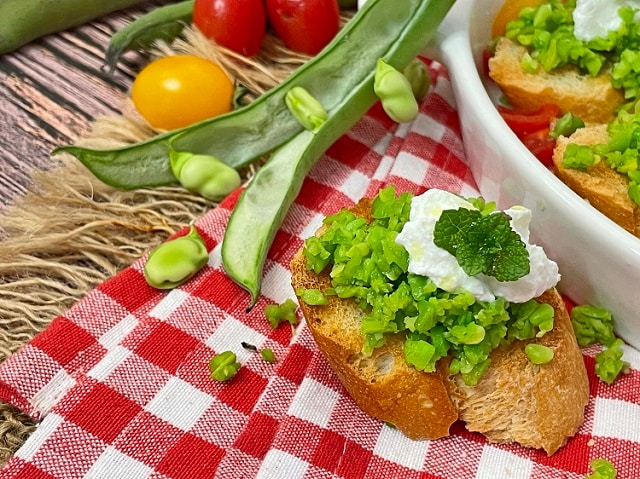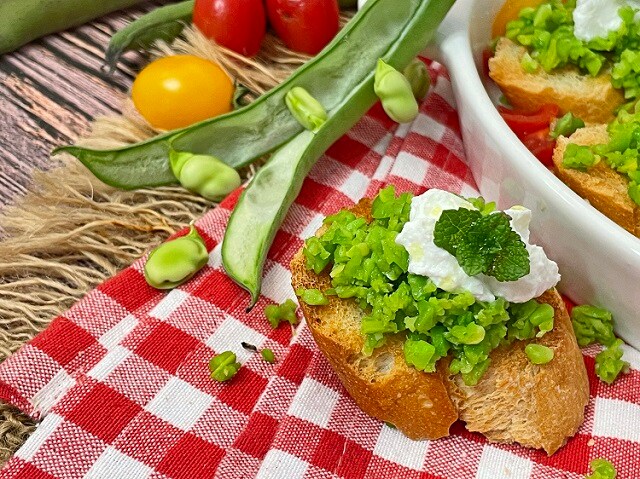Vegetarian Bruschetta: Freshness and Tradition with Fava Beans, Ricotta, and Pecorino
Dear friends, there’s something magical about recipes that are deeply rooted in our culinary history. And when it comes to simplicity and authentic taste, bruschetta is always front and center.
Today I bring you an idea that is a tribute to Italian tradition: my Vegetarian Bruschetta with a pairing that, I assure you, is a true classic with ancient origins: fava beans, ricotta, and pecorino.
Forget about overly elaborate bruschettas! This proposal is a real concentrate of freshness and delicacy, perfect for countless occasions.
Whether it’s for a family Sunday brunch, a light and tasty lunch, or to accompany an aperitif with friends, this bruschetta will win you over.
Imagine the crunchiness of a slice of toasted bread as a base for a winning trio: the sweetness of fresh fava beans, turned into a velvety cream scented with mint, perfectly balanced by the delicacy of a ricotta mousse enriched by the savory touch of pecorino and lemon zest.
It’s a combination that comes directly from ancient Rome, appreciated for nearly 2000 years for its balanced flavor and incredible simplicity. And it is precisely in the simplicity of the ingredients and the freshness of their pairing that the secret of this delight lies.
Preparing it is a breeze: a few steps for a result that will surprise and delight you.
And for more ideas for buffets and aperitifs, here are other recipes

- Difficulty: Very easy
- Cost: Inexpensive
- Preparation time: 20 Minutes
- Portions: 4
- Cooking methods: Stovetop
- Cuisine: Italian
- Energy 620.74 (Kcal)
- Carbohydrates 37.35 (g) of which sugars 4.08 (g)
- Proteins 26.25 (g)
- Fat 40.36 (g) of which saturated 14.39 (g)of which unsaturated 5.26 (g)
- Fibers 6.18 (g)
- Sodium 4,039.78 (mg)
Indicative values for a portion of 100 g processed in an automated way starting from the nutritional information available on the CREA* and FoodData Central** databases. It is not food and / or nutritional advice.
* CREATES Food and Nutrition Research Center: https://www.crea.gov.it/alimenti-e-nutrizione https://www.alimentinutrizione.it ** U.S. Department of Agriculture, Agricultural Research Service. FoodData Central, 2019. https://fdc.nal.usda.gov
VEGETARIAN BRUSCHETTA Ingredients
- 4 slices bread
- A few leaves mint
- 1.76 oz pecorino (shaved for garnish)
- 1 drizzle extra virgin olive oil
- 28.22 oz fava beans (fresh, about 10.58 oz shelled)
- 3 tablespoons extra virgin olive oil
- 0.7 oz pine nuts
- A few leaves mint (fresh)
- 1 pinch salt
- 5.29 oz ricotta
- Half lemon (grated zest)
- 1 tablespoon pecorino (grated)
- to taste salt
- 1 pinch black pepper (ground)
VEGETARIAN BRUSCHETTA Step-by-Step Procedure
First, shell the fava beans from their pods. Bring a small pot of water to a boil. Once boiling, plunge the shelled fava beans in for about 30 seconds. This very brief step will make them easier to “peel”. Drain them immediately and run them under cold running water to stop the cooking.
Remove the outer skin covering each fava bean. It’s a step that requires a bit of patience but will make the cream much more delicate and digestible. Place the cleaned fava beans in the immersion blender cup or mixer, add the pine nuts, fresh mint leaves, a pinch of salt, and the extra virgin olive oil.
Blend everything, drizzling in the oil, until you get a smooth and homogeneous cream. If necessary, you can add a teaspoon of cold water to reach the desired consistency. Taste and adjust the salt.
In a bowl, combine well-drained cow’s milk ricotta, the grated zest of half a lemon, grated pecorino, a pinch of salt, and a grind of fresh black pepper.
Stir well with a spoon or fork until you get a smooth and homogeneous mousse. Taste and, if necessary, adjust the flavor.
Heat a non-stick skillet or grill pan. Toast the slices of bread until they are golden and crispy on both sides. You can also use a toaster.Arrange the toasted bread slices on a serving plate or board.
Generously spread a thick layer of fava bean cream on each slice of bread.
With the aid of a spoon or a piping bag, place a dollop of ricotta and pecorino mousse on top of the fava bean cream.
Finish each vegetarian bruschetta with a drizzle of raw extra virgin olive oil, a few shavings of pecorino (for an extra touch of savoriness), and one or two fresh mint leaves for fragrance. Serve your vegetarian bruschettas immediately!
STORAGE
This vegetarian bruschetta is best enjoyed immediately after preparation, while the bread is still crunchy. You can prepare the fava bean cream and the ricotta mousse in advance: store them separately in airtight containers in the refrigerator for up to 2 days. You just need to toast the bread and assemble the bruschettas shortly before serving to ensure maximum freshness and crunchiness.
Notes on Ingredients and Possible Substitutions
PECORINO: The pecorino should be very flavorful and slightly spicy, so choose an aged pecorino like the Roman or Sardinian type. If you prefer, you can use parmesan, feta, or other fresh cheeses.
BREAD: Do not choose bread that is too soft. The ideal bread should have a nice crust that becomes crunchy when heated, and a firm crumb, but not too firm. A baguette could also work well.
To heat it, use a grill or pan, or brush it with a little oil and put it in the oven at 350°F for about 10 minutes. If you wish, you can flavor the oil with a clove of garlic or aromatic herbs.
FAVA BEANS: Along with fava beans, you can add fresh peas or, following the same recipe, use only peas.
ORIGINS – Pecorino Romano, cheese made from sheep’s milk, has its origins in ancient Rome and its preparation has remained the same over the centuries. The Roman tradition celebrated the arrival of spring on May 1st with a convivial lunch in the countryside featuring crostini with fava beans and pecorino. During this grand festival, which involved the entire city, people exchanged wishes of serenity and prosperity for the summer season.
Creative Alternatives and Variations
Your vegetarian bruschetta can be transformed in a thousand ways!
Extra Sweetness: For a vegetable bruschetta with an even more delicate and sweet flavor, add boiled fresh peas (about 3.5 oz) to the fava bean cream or substitute part of the fava beans with peas.
With Cherry Tomatoes: Add some halved cherry tomatoes seasoned with a drizzle of oil on top of the ricotta mousse for a touch of color and acidity.
Different Herbs: Besides mint, try adding a pinch of fresh thyme or dried oregano to the fava bean cream or the mousse.
Vegan Variant: For a completely vegan version, you can replace the ricotta with a cashew cream (soaked and blended with a little water and nutritional yeast) and omit the pecorino, using a grating vegan cheese if desired.
Creamy Avocado: For an even richer texture, add a few thin slices of ripe avocado on the fava bean cream before the mousse.
Uses and Pairings
The vegetarian bruschetta with fava beans, ricotta, and pecorino is a true all-rounder in the kitchen:
Gourmet Appetizer: It’s an elegant and flavorful finger food, perfect to start a dinner or a happy hour.
Perfect Brunch: Its textures and flavors make it ideal for enhancing a brunch, accompanying eggs, cheeses, and fruit.
Light Appetizer: A great alternative to more elaborate appetizers, it whets the appetite without being heavy.
Quick Meal: Accompanied by a fresh salad, it becomes a light, complete, and nutritious lunch or dinner.
Creative Side Dish: It can accompany main courses based on fresh cheeses or grilled vegetables.
The Millennial History of Bruschetta and the Triumph of Fava Beans, Ricotta, and Pecorino
Bruschetta is not just a simple appetizer, but a symbol of Italian peasant and rustic cuisine, an art that dates back to ancient times. Its name derives from the Roman term “bruscare”, meaning “to roast over coals”. Originally, it was the simplest way to enjoy freshly pressed oil: a piece of stale bread toasted, rubbed with garlic, and seasoned with new oil and salt. A gesture of pure simplicity celebrating the quality of the products of the land.
The combination of fava beans, ricotta, and pecorino has an equally fascinating history, deeply rooted in Roman and Lazio tradition. Already the ancient Romans, in spring, used to consume fresh fava beans, often accompanied by sheep cheese and bread. Fava beans, in fact, were a fundamental, nutritious, and easily accessible food. Ricotta, a by-product of cheese-making, represented an ingenious way to waste nothing, offering a soft texture and delicate flavor. Pecorino, with its decisive savoriness, completed the picture, creating a perfect balance of sweetness, creaminess, and taste. This combination, therefore, is not only tasty but tells centuries of agricultural and gastronomic history of our country, a true hymn to “from farm to table” cuisine.
FAQ (Questions and Answers)
Can I use frozen fava beans for this recipe?
Yes, you can use frozen fava beans if you don’t have fresh ones. I recommend blanching them for about 1-2 minutes instead of 30 seconds to ensure they are tender, then chill them in ice water and proceed to remove the skin as you would with fresh fava beans. The taste will still be excellent!
What’s the secret to a crunchy bruschetta?
The secret to perfect bruschetta is toasting the bread! Use slices of bread that are at least 1.5-2 cm thick and toast them well, on a grill, in a pan, in a toaster, or under the oven grill, until they are golden and have a crispy outer crust. It’s important that the bread is very crunchy to hold the topping.
Can I prepare the fava bean cream in advance?
Absolutely yes! The fava bean cream can be prepared in advance and stored in an airtight container in the refrigerator for 2-3 days. In fact, sometimes the flavors settle better. I suggest keeping it separate from the ricotta mousse and assembling the bruschettas only just before serving to maintain the freshness and crunchiness of the bread.

